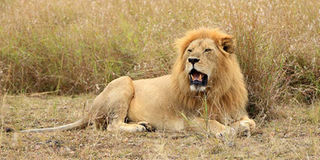
A lion in a national reserve.
In 1937, as Kenyan workers led by Makhan Singh staged a 62-day strike in Nairobi to demand high wages and better work conditions, another Kenyan by the name Njeru was mauled to death by lions while working in near slave-like conditions in a menagerie in London.
He lived in a cage, ate from tins and his employer retained his wages.Travelling exhibitions of exotic wild animals known as menageries were very common in Britain in the 19th and early 20th Century. These elaborate shows were staged in major cities and attracted huge crowds.
The aim of these travelling exhibitions was to excite and thrill the audiences and demonstrate Britain’s dominance over its empire. They featured Cheetahs, Zebras, lions and hyenas brought in from Africa and Asia for entertainment.
Read: Archives reveal 1960s London-Washington pingpong and near fallout over Jomo Kenyatta succession
But what captivated the audience most were people known as the ‘lion tamers’, who entered the cages to stage performances with the lions, tigers and hyenas as a show of bravery and dominance over wild animals. Most of these lion tamers were Blacks, especially from Africa.
It was under a similar situation that Njeru found himself in London after a proprietor of a menagerie transported him together with other wild animals such as Cheetahs, lions, monkeys and hyenas to stage performances in North London in 1937.
He had his own cage which served as his accommodation in the menagerie Njeru was discovered by Jomo Kenyatta and Mbiyu Koinange, who were then living in London, the former as an agitator of Kikuyu rights and a student at London School of Economics and the latter as a student at the University of London on Gower Street, having left Cambridge.
The two were attending the menagerie when they realised that the lion tamer in the cage was from the Mount Kenya region. He could only converse in his native Embu language.
“The presence in Britain of one of our countrymen from Embu stirred us to furry,” Koinange later recalled. When they spoke to the poor man, he told them that the proprietor of the menagerie retained his wages until the day they would return to Kenya. This was perhaps meant to prevent him from escaping from the danger of entering the lion’s cage to entertain the crowd by teasing the animal.
When Kenyatta and Koinange entered a cage, which served as Njeru’s accommodation, they were left dumbfounded with the near animal-like conditions the man was living in. For food, he had maize meal, salt and water.
And for utensils, he used mikebe (tin) “When we visited his cage, we found him supplied with maize meal, salt and water for his food. For a saucepan, he used a gallon of tin cut into half, and a small empty milk tin for a cup,” Koinange narrated.
Touched by Njeru’s predicaments, the two offered to take him to the Corner House restaurant in London’s Oxford Street for lunch. However, he was so used to the inhumane surroundings of the menagerie that he struggled to eat in the restaurant.
The change of environment was too sudden for him. Koinange and Kenyatta observed this and decided to take away the lunch to the expansive St James’s Park near Buckingham palace, where they ate in the open.
Koinange later took Njeru to his house so that in case of any problem, he would know where to find him.
He then returned him to the menagerie in Wembley Park and as they parted ways, they agreed to meet again soon. However, this never happened after Njeru was mauled to death while performing a show with the lions inside the cage.
Mbiyu and Kenyatta, after receiving the sad news, approached the proprietor of the menagerie over the incident, but he became evasive. The two decided to pursue justice for their fellow countryman by raising the matter with the Colonial Office in White Hall.
“We pursued the matter with the colonial office until we were assured that the relatives of this enslaved man were given his savings,” Mbiyu recalled. However, Njeru wasn’t the only Kenyan who looked after wild animals abroad. In 1934, Terengosi, a Maasai from Kajiado, was flown to America with a baby elephant nicknamed ‘Toto tembo’, which had been captured in Nairobi by Mr and Mrs Martin Johnson.
On arrival in Missouri, the Johnsons offered Toto tembo to St Louis Zoo at a price of $2,500 with Terengosi remaining there as its keeper, perhaps making him one of the earliest Kenyans to settle in modern America.When the Central Park Zoo in New York was opened later that year in December 1934, a decision was made to move the baby elephant from St Louis Zoo to New York with Terengosi also moving there as its keeper. This made him one of the earliest Black keepers at the zoo.
One journalist who visited Central Zoo just after its opening, wrote: “Terengosi, native youth from the African colony of Kenya, is in charge of the elephant....”
Even though it is difficult to tell whether Terengosi had suitable terms of employment, it is certain that at some point he was not subjected to racism that was rampant in America at that time. It was in the same city of St Louis where Terengosi had first worked that a Congolese boy known as Ota Benga was put on display at the Louisiana Purchase Exposition in 1904.
Benga was later moved to Bronx Zoo in New York, where he was put on display as a human zoo exhibit and shared a cage with Orangutans in 1906.










